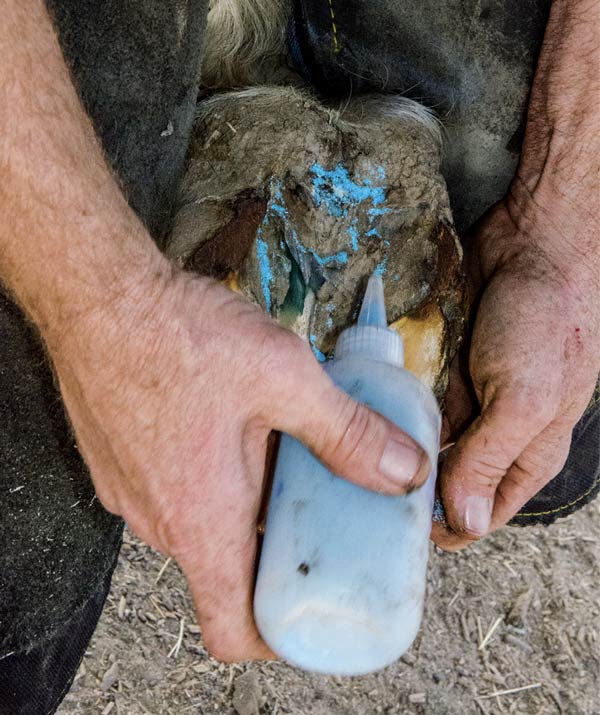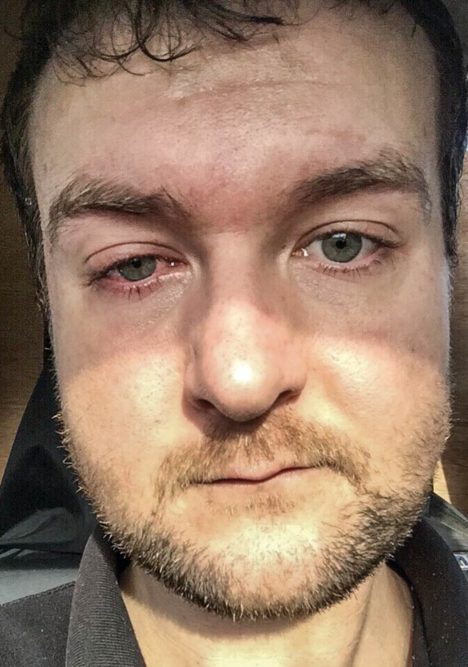Pictured Above: A gust of wind blew copper sulfate powder into British farrier Samuel David Rice’s right eye, despite the farrier wearing safety glasses. His eye remained swollen shut more than an hour.
When providing hoof care on a regular schedule, many farriers see horses every 6 to 8 weeks and the nature of the footcare business is to provide a solution that works best for a horse within that interval. Yet, bacterial- and fungal-induced diseases such as thrush often thwart those best intentions.
A remedy traditionally has been a mixture of copper sulfate and water to form a paste, packing the compound into the infected area of the hoof. The solution, according to those who utilize the compound, has worked in their practices and provided a cost-effective treatment to the thrush cases they see regularly. Conversely, other professionals deem the practice unsafe for both horse and farrier, and also cite environmental concerns.
Farrier Takeaways
- Educating horse owners about keeping hooves clean in between trims can help reduce the recurrence of thrush and reduce copper sulfate use.
- Wear gloves and safety glasses when handling copper sulfate to avoid potential irritation.
- Copper sulfate binds to proteins and enters different organs when inhaled or eaten. It takes between 13 and 33 days for only half of a large dose to be eliminated from the body.
Health Implications
Using a cheap and powerful remedy can be appealing for farriers; however, it is important to remember the negative implications the fungicide can impose, in addition to its curative benefits.
Outside of the farrier industry, copper sulfate is primarily used as a fungicide to control bacterial and fungal growth in bodies of water. The Environmental Protection Agency has established a maximum allowable limit of 1 part per million or less in drinking water.1 Although toxicity typically occurs at higher concentrations, the agency has deemed 1 ppm as the necessary limitation in the prevention of maintaining both the “acceptable taste” and safety of drinking water.
A powerful oxidizing agent, the human body naturally contains 50-120 mg of copper and is an essential element required to support proper health. However, when exposure occurs in larger quantities, either through absorption or ingestion, health will be impaired.
According to the National Pesticide Information Center (NPIC), copper sulfate is rapidly absorbed into the body and, correspondingly, the bloodstream once eaten or inhaled. The compound subsequently binds to proteins and enters different organs. And while the excess copper is mostly excreted from the body, deposits can be found in the liver, stomach secretions, bone, brain, hair, heart, intestine, kidneys, muscle, skin and spleen. The center’s compilation of research also finds that it takes between 13 and 33 days for only half of a large copper dose to be eliminated from the body.2
Rapid absorption is an attribute of copper sulfate that Samuel David Rice can attest to. Like many farriers, Rice employs the use of powder copper sulfate in the treatment of thrush and other fungal infections of the hoof. As the Wigan, England, farrier found, copper sulfate can prove dangerous even when proper safety precautions — such as wearing safety glasses and gloves — are followed.
Within minutes, my eye was so swollen I could no longer open it …
“When I was pouring some pure copper sulfate powder into a frog directly from the tub, a small gust of wind blew some of the powder straight into my face,” Rice recalls. “It was probably only a couple of grains of powder that managed to make it around the glasses and into my right eye. As soon as I felt the powder hit my eyeball my first reflex was to blink repeatedly, which only helped to dissolve the powder and smear it across my eyeball. My vision in that eye immediately turned a vivid shade of blue and I felt an intense burning pain.”
Rice rushed to the nearest water source to rinse his eye with cold water, but his body reacted quickly to the substance.
“Within minutes it was so swollen I could no longer open it, and when I forced it open I was completely blind,” he says. “Obviously at that point panic set in, and I rinsed it even more. My sight started to return within about 5 to 10 minutes but it took probably a good 20 minutes before I could see clearly again. The eye was still swollen shut at that point but I at least knew that I hadn’t been permanently blinded.”
Rice says that it took more than an hour before he could open his eye once again, and even then he experienced a burning pain and constant watering of the eye. His sight remained blurry from both squinting through the pain and the tears produced by the irritation. After approximately 3 hours, the eye pain subsided and gave-way to what Rice describes as a “remarkable” headache for the remainder of the day.
Although the repercussions of handling copper sulfate weren’t permanent, or even long-lasting, clearing up by the next day with only redness persisting beyond 24 hours, Rice says that the experience has made him implement additional precautions when handling copper sulfate powder.
“I still always wear eye protection, but I won’t ever pour the powder directly onto the hoof, straight out of the tub, again,” Rice says. “I now transfer it into a smaller bottle with a nozzle, and I do the transferring indoors, out of the wind. I also cover the raw powder with Play-Doh, or I knead the powder into the Play-Doh to act as a medium for application.”
Does it Help or Hinder the Hoof?
There is a multitude of products and remedies used in the farrier industry, each claiming to correct fungal and bacteria created hoof issues.
Critics of copper sulfate recommend that farriers use products that are not chemically caustic to the proteins of the hoof wall or sole. Namely, because even though caustic chemicals and materials might destroy the organisms on the surface, they also denature the proteins of the hoof capsule and block the penetration of oxygen. When a caustic solution is used, a farrier is essentially feeding the invasion of anaerobic hoof-eating microbes.
Danny Berry, a Galt, Mo., farrier, agrees and shares that while he commonly used copper sulfate in the past and saw good results, the availability of better, safer and affordable thrush treatments, combined with better owner hoof care between his service visits, have allowed him to employ a different avenue of care.
“I shoe about 200 horses a month and all are on a 5-week schedule,” Berry says. “My clients are all regular and, honestly, I don’t have to use as many medications as I did when I first started. Education has been a big part of growing my business, and teaching my clients how to care for and clean their horse’s hooves during the 4 weeks I don’t see them, has helped us all.”
Berry says that of the horses he shoes, he only sees thrush in about 3%, which he attributes to education and responsible owner maintenance between his scheduled visits.

Rice transfers copper sulfate powder into a smaller bottle with a nozzle to help avoid wind gusts blowing it into his face. He also applies it to the hoof by kneading it into Play-Doh.
Consider Your Environment
Additional considerations have been raised from the hoof-care industry regarding the safety and environmental concern of copper sulfate runoff polluting water and stream sources when a horse defecates or urinates. Noting that keeping copper sulfate in the horse’s hoof where it belongs is almost impossible.
Leaching of the mineral into the environment can come with negative consequences, according to NPIC.
While the organization cites little concern for the accumulation of copper within surface soils, where the mineral is regulated by plants, extremely high copper deposits can lead to prohibited plant photosynthesis; however, toxicity at this level is typically associated with direct application of hog manure or other applied waste.2
Streams and small bodies of water, on the other hand, can become toxic to the fish and other wildlife who inhabit them with copper levels as low as 0.33 ppm. The U.S. Environmental Protection Agency considers copper to be highly to very toxic to fish and aquatic life.
Most fish-kill results from the depletion of oxygen in bodies of water where the highly soluble copper sulfate binds to the sediments within the water. The high toxicity of copper sulfate in aquatic habitats has caused many wildlife groups to call for the mineral to be banned as an algaecide.
While there is no ban on the use of copper sulfate in the farrier industry, a professional and educated approach should be used.
References
- Reregistration Eligibility Decision (RED) for Coppers; U.S. Environmental Protection Agency, Office of Prevention, Pesticides and Toxic Substances, Office of Pesticide Programs, U.S. Government Printing Office: Washington, D.C., 2009: 11.
- General Fact Sheet: Copper Sulfate. National Pesticide Information Center, 2012; npic.orst.edu/fact
sheets/cuso4gen.html.









Post a comment
Report Abusive Comment